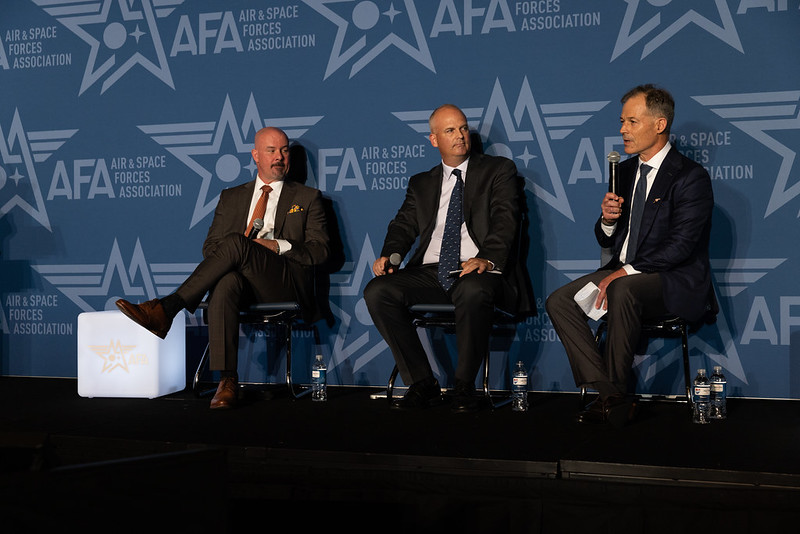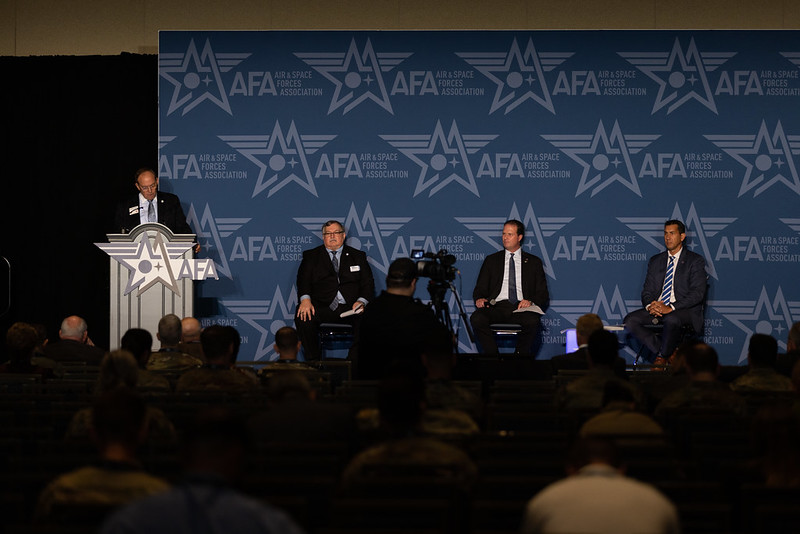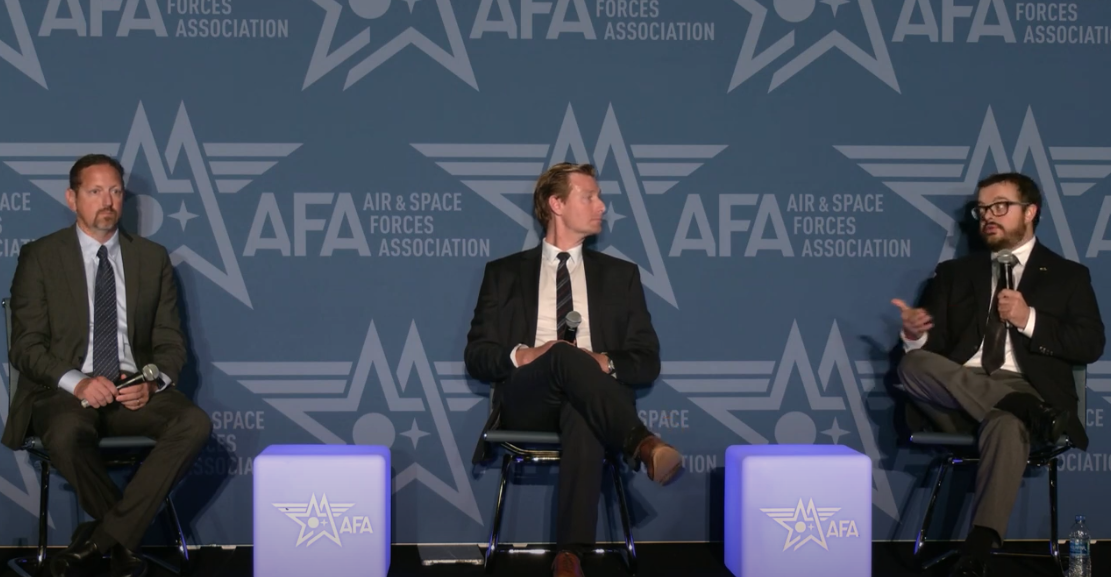Lt. Gen. James C. Dawkins, deputy chief of staff for strategic deterrence and nuclear integration, moderated a discussion on “Nuclear Modernization” with Michael Beltrani of General Dynamics Mission Systems, Elaine Bitonti of Collins Aerospace, and retired Lt. Gen. James “Jim” Kowalski of Northrop Grumman, Sept. 21, 2022, at AFA’s Air, Space & Cyber Conference. Watch the video or read the transcript below. This transcript is made possible by the sponsorship of JobsOhio.
If your firewall blocks YouTube, try this link instead.
Lt. Gen. James C. Dawkins:
Good afternoon and welcome to this session on Nuclear Modernization. I’m your moderator, Lieutenant General Jim Dawkins, and I serve as the Air Force Deputy Chief of Staff for Strategic Deterrence and Nuclear Integration. Nuclear deterrence underwrites every US military operation around the globe. It is the back step and the foundation of our national defense and the defense of our allies. Our deterrence capabilities are especially critical in the emergent strategic environment where the US is competing against two nuclear armed peers who are not only modernizing their arsenals, but also pursuing new novel capabilities. The threats we face today and into the future are especially concerning when juxtaposed next to the Cold War era nuclear weapon systems and infrastructure that we continue to operate and depend upon.
As such, the modernization of our nuclear deterrent has become a top national security priority. This presents a complex technological challenge since all three legs of the triad and our nuclear command and control and communication systems are undergoing modernization simultaneously. By 2030, the Air Force will be fielding a new stealth bomber, the B-21, a new ICBM system or Sentinel, a new strategic bomb, the B61-12, a new ICBM warhead, a new cruise missile, the LRSO, a B-52 that’s modernized with new engines, radar and advanced communications equipment, a new helicopter for missile field security, the MH-139, and a myriad of NC3 systems, with the SEOC soon to follow. There’s no margin for delay on any one of these systems. The emerging threat, the need for speed, and increasing cost demand that we pivot away from ponderous processes. We have to do things right, but on a faster pace that we’ve done in the past.
Fortunately, the introduction of innovative processes like digital engineering and cloud-based computing can help us get there. We’re also aided in our nuclear modernization efforts with great industry partners leading the cutting edge of technological transformation, and these folks are critical to helping us with modernization challenges. With that, let me introduce our expert panelists. The Vice President of Strategic Mission Systems and General Dynamics, Mr. Michael Beltrani. Vice President JADC2 Experimentation and Demonstration, and Business Development at Collins, Elaine Bitonti. And vice President, Government Programs, Northrop Grumman, Lieutenant General Jim Kowalski, retired. Michael, we’re going to start with you for some opening comments.
Michael Beltrani:
Thank you, sir. I would first say that you called three of us experts. I’m definitely not an expert, the other two are. I’m honored to be with them. Ask them all the hard questions. Just a little bit about GDMS for the folks who maybe not as familiar, we’re pretty different in that we have our entire strategic portfolio on one team, my team, and that portfolio spans about 60 years of legacy. Whether we’re talking about the work we do with the Navy and SSP on Ohio and, now, Columbia-class submarines, the guidance and production work we do with Lockheed and Draper and SSP on the Trident missile or what we do more close to live, you here at AFA for the Air Force, both with NC3 legacy, NC2 systems like Direct, Direct Light, NC3 systems like Global Ascending Two.
What we’re doing on the Sentinel program and as well as with Northrop Grumman, as well as some of the Minutemen programs that we continue to support and sustain. It’s a crazy time. Right? The world has changed. Modernizing all of that stuff at the same time is kind of crazy when you… It’s almost insane. It’s long overdue. Really look forward to digging into some of these topics today. Thank you all for being here.
Lt. Gen. James C. Dawkins:
Thanks, Michael. Over to you, Elaine.
Elaine Bitonti:
Good afternoon and thank you Lieutenant General Dawkins for hosting this very timely panel. I’m Elaine Bitonti. I’m here from Collin Aerospace. From Collins Aerospace perspective, we have been involved in supporting the nuclear command and control and strategic deterrence mission really since the inception of Strategic Air Command. We partnered with them back in the initial days to set up the first network that was used in the very first bomber missions. Since that time, we’ve really focused on how do we continue to expand that support with a lot of the enablers. At Collins Aerospace, we don’t make any platforms. We don’t make any effectors like our partners at Northrop Grumman, but we do make many enablers that make those systems very effective from the communications, VLF, UHF, HF, also to the message processing systems and the other mission systems that are so critical to the NC3 enterprise and the strategic assets that we’re all here supporting.
We’ve really taken a focus from a Collins perspective of as we look to speed up, how this modernization happens and make sure we deliver on the schedule needed for the war fighter. How do we leverage more from the conventional space into the NC3 space and how do we leverage open systems to really keep pace with those threats? Because we’re modernizing the systems today, but as we know, the threat will continue to evolve. How do we make sure those newly modernized systems are resilient and flexible as we go forward? We look forward to your questions today and talking further about that.
Lt. Gen. James C. Dawkins:
Thanks, Elaine. Jim.
Lt. Gen. James “Jim” Kowalski (Ret.):
Thanks. Well, thanks, General Dawkins. I appreciate what you said there in your opening too. There’s widespread acknowledgement of the problem the nation and really all the democratic nations are facing now with the rise of these authoritarian regimes, the return of great power competition in this multipolar near peer nuclear deterrence problem that we’re currently facing. I want to touch on this briefly because it’s important to step back and see the larger picture before we get too much into the acronyms and the details of how we’re solving this problem. From the government side, they’re the ones, along with academia and the think tanks, they’re going to have to do the deep thinking on this problem because it’s not a problem we faced before. And then we think about, well then, what’s industry’s role here? Industry’s role at this point, I think, right now, is take full advantage of digital engineering, take full advantage of the open architectures and where we can go with those and to take full advantage of cloud, cloud software, and agile software, as ways to update our systems as fast, as quick as possible, as this threat rapidly evolves going forward.
Fortunately, we have started the nuclear recapitalization just in the nick of time. It started during a period where we really didn’t see this threat that we’re facing now on the horizon yet, but now we’re heading in the right direction where we’ve got some headwinds out there. One of the things that was really highlighted, and I don’t know if everybody caught it, but we’ve run out of time. The schedule for all of these programs is very critical and we’ve got some headwinds out there. We’ve got an inflation problem. We’ve got a workforce problem, and we’ve got supply chain issues. I don’t think those are permanent, but I also don’t know when they’re going to end. Right now, that’s part of what all the programs are having to struggle with as we focus on the schedule. Thanks.
Lt. Gen. James C. Dawkins:
Thanks, Jim. We’ll stick with you for the first question. As industry proceeds with the modernization, the challenges that you just mentioned, how does Northrop Grumman or how do you account for the rapid evolution in the environment that you also spoke about?
Lt. Gen. James “Jim” Kowalski (Ret.):
Well, I sort of laid that out first because I talked about digital transformation, the agile software, open architectures, and digital engineering. When you have that digital design and you start with a digital design, and you’re able to take that design and weave it through all of the systems that you have there, your production system, your maintenance system, how you maintain a platform, how you sustain a platform, how you train people in platforms, and when they all have that digital model of the platform itself and their elements within that platform, you can see quickly how all of this ties together. The use of VR tools to do training, the use of VR tools to figure out where the problems are in the design and work them out early, where the problems are in maintenance, and get those worked out early. Those are all key elements as how we go forward.
Let me give you an example of this. That is you’ve got a weapon system that has been done with digital design. You have these digital tools. It’s an open architecture. The threat evolves. Now, you need to put a new weapon. Maybe that weapon needs new guidance, maybe it needs new overhead, maybe it needs maneuverability or some other attribute, but you need to put a brand new weapon on a system. Today, that takes years. With digital designs, we can do it in months. That’s really the power of this. That’s how we’re going to get inside of the adversary cycle times going forward.
Lt. Gen. James C. Dawkins:
Thanks, Jim. I also think there’s going to be some carryover from how you design these systems and build them with that digital engineering on how we train our forces, whether it’s virtual reality or other things. I look forward to the implication of that as we field these systems in or between now and ’30, and then how we train on them and sustain them using some of these same tools. Turning to Elaine. I can touch on a little bit of hypersonics. The development of hypersonics, AI and machine learning technologies. We’re going to cut into the time that national leadership has to make a decision during a crisis. What technology investments should we be making to address this and how should we account for emerging technologies when we think about modernizing our NC3 systems?
Elaine Bitonti:
Yes, thank you. I think that’s a really important thing to think about is Northrop Grumman mentioned the threat will continue to evolve. I think some of the things we need to make sure we’re investing in is advanced sensors so that we can properly detect what’s happening from the enemy side and be prepared to react. I also think how we’re going to integrate artificial intelligence into the decision making process is going to be really critical. Humans can only process data at a certain rate. Let’s just talk about from a communications perspective. You may have multiple different contingent plans if your communications go down. Humans can only remember so many. If we use artificial intelligence, the machine can remember only an infinite number, right? To what it’s programmed. I think thinking about how do we use things like that to make sure when the threat evolves and a contingency occurs, we’re best positioned to address it.
I also think to the point that Jim made about how do we keep these systems updated? I think, one, it is about the open architectures, but it’s also about how quickly can you change that? When we look at some of the networks, if we have an emerging threat and we see a particular wave form, a particular link, as not being effective, how quickly can we change that on the platform? Do we have to take that subsystem out and do it? Can we reprogram it over the air? That’s really where we have to get to from an industry perspective to be able to be agile.
Lt. Gen. James C. Dawkins:
Thanks for that. Michael. As important as our weapon systems and platforms, they are nothing without people. Given the urgency of the nuclear mission in today’s environment, how has industry changed to attract, retain, and develop talent for the nuclear mission? Something by the way that I’ve sensed from a lot of the industry that I’ve engaged with this week, that is a challenge.
Michael Beltrani:
Yeah, I know. Great question. It is a huge challenge, right? Coming out of COVID, everybody I think had much higher attrition than normal. Folks now have flexibility to work remotely at other companies and that relocate their family. That was never a problem statement that we had before. How do you reduce your attrition and attract new talent in a different model? As all of you know or many of you know, I’m sure, the security program classification of these programs makes it really hard to work remote most of the time. You’re competing in a workforce against companies that offer that as an option. That’s pretty desirable for the work-life balance. What do you do to really drive that in the other direction? What we’re really focused on is, I mentioned before the GDMS’s portfolio across the triad plus NC3. With all the modernization going on plus the sustainment, there’s so many different challenges that engineers can go work on where you’re not just a sustainment engineer on program A for 10 years. You can move around and have diversity of experience within the deterrent.
I think that’s really important to get people excited about work. But, more importantly, what we’ve done recently is taking our higher potential employees and giving them exposure to customer engagement activities. Admiral Richards hosted a symposium, NC3 symposium, back in June in Omaha. We brought 20 of our best and brightest future leaders to that symposium. How often does 22, 23, 24-year olds get to listen to Admiral Richards kind of talk about the state of StratCom? Each person was really excited coming out of that event. When they get back to the office and they were able to communicate what they heard, everyone’s raising their hand and said, “Hey, when do I get to go there and do that?” Now, it was also held at a zoo so that was cool too. But I think at the end of the day, I think giving it maximum exposure to senior leaders that a lot of them in the room and, many of us talked about that today and yesterday, goes a long way in keep keeping people excited about the mission and wanting to stay with the company.
Lt. Gen. James C. Dawkins:
Elaine or Jim, would you care to comment on some of those challenges and how you’re addressing them?
Elaine Bitonti:
Yeah, I think we’re facing definitely similar challenges as Mike outlined, especially a lot of our programs like this are executed out of major metropolitan areas where there’s very high competition for talent. One of the things that we’ve found is we can’t take away the fact that people do have to be on site to do this type of work, but we have invested at Collins a lot of money and, I’ll say, upgrading all of our classified skiff space so that it is, I’ll say, not the skiff space of old.
You really have more amenities inside of the skiff, right? Things that people can do. We’ve really worked to build a team culture in there, have different food. I think things that just make people feel more at home. Yes, they have to be in this in enclosed area, but we have found, especially with the younger generation, that has gone a really long way to say, “Yes, we know you have to come into the office, but we’re going to make sure that the workspace you’re in is very up to date, very modern.” That has been, I’ll say, one of the biggest positives that we’ve heard from our workforce, is the changes we’ve made in that area.
Lt. Gen. James C. Dawkins:
“No cell phone but we’re going to feed you,” is what I heard there. That’s great. Jim, any thoughts on that?
Lt. Gen. James “Jim” Kowalski (Ret.):
At Northrop, we sort of have both a near term approach and a long term approach. Near term approach obviously is to be out there with competitive pay, flexible work hours. We’ve upgraded, particularly in the Sentinel program, we’ve upgraded the campuses to state of the art. Long term, there’s a minimum requirement for a small business participation in a contract. We’ve expanded that, not only to share that workload, but also get some of the innovation and the good ideas from the smaller businesses that are out there. We’ve partnered with universities. We’ve got internships. A lot of the things that are in the toolkit for solving a hiring problem longer term and building out that pipeline. But I think one of the most important things we offer, particularly with both the B-21 and the Sentinel program is that opportunity to participate in something historic. I mean, if you want to graduate from college and go to work for TikTok and figure out how to load videos faster, hey, knock yourself out. Or you can stand tall against anarchy by authoritarian regimes. Come work for Northrop.
Lt. Gen. James C. Dawkins:
Thanks, Jim. Jim, keeping with you for the next round of questions. After repeated criticism of the defense industry is the lead time between contract award and roll out of the weapon systems, what has Northrop Grumman done to maintain a sense of urgency during the years long development processes and how do life cycle costs and acquisition processes help or hinder this effort?
Lt. Gen. James “Jim” Kowalski (Ret.):
Well, one of the things that we do in our programs is we build in milestones earlier than the contract baseline. We sort of induce that kind of schedule pressure, that idea of having stretch goals out there because we want to drive the workforce to be looking for ways that we can reduce risk. That is really one of the advantages that digital engineering has allowed us to do, is it’s given us more opportunities to find and mitigate that risk early on, as opposed to programs where you don’t find a problem until somebody who’s putting a component together realizes that this isn’t going to work and everything has to stop and you go backwards. We’re looking for that risk reduction early on and then we find it. Can we bring the critical path down that way? There’s constant pressures in a program that… Major acquisitions program. They all want to slip because all you’re going to do out there is find issues.
But the digital has been really huge in helping us overcome this. In terms of the life cycle cost, really what we have found… Both of these programs were designed to use digital in those other systems so we’re bringing that digital forward. We’re actually looking at maintenance. How do we do maintenance before anything has even produced. We were through the VR process figuring out how to replace components and the best ways to do that. We were bringing down the time it takes to repair items before the design was even fully baked. We brought maintenance into that process to be able to sign off on those kind of things in our programs. What you find out when you do that is that doesn’t make it take longer. What it does is it shortens that cycle. In particular, and what’s really critical here, is it shortens the cycle to fielding and to initial operational capability. How everybody gets wrapped up in a lot of milestones.
The one we really ought to be focused on is when do we put an effective weapon system on the ramp or in the silo? That’s what’s really going to make a difference for us. From the acquisition perspective, really, I think the acting RCO director, Melissa Johnson, had a comment yesterday about the tightness of the team and about how the transparency and what a close-knit team they are in the B-21 program, and how much of that helps because they share common goals. They’re in a transparent system. They have daily communication and they’re working together to find, not only ways to solve the problems, but ways to get out ahead of those problems. How can we be innovative and how can we invest money a little bit differently and sort of actively manage this contract? Together, the government and the industry partners, can bring down that risk. Of course, Global Strike Command, as the user, is tied into that loop also.
Lt. Gen. James C. Dawkins:
No, that’s great. Of course, keeping the requirements stable has been very helpful in these programs as well. To your point, after you get the missile on the ground with the airplane in the air, how do you modify that as you go forward and evolve it for the threat, whatever they may come next? Elaine, you know I’ve talked about NC3 before and JADC2. As the secretary just mentioned some… I made some news this week about program manager for JADC2, ABMS, if you will, as well as the consortium defense industry to help tackle this problem. Again, we’ve talked about how do we leverage what they’re doing or how do they leverage what we’re doing in NC3 to get after that challenge?
Elaine Bitonti:
Yeah. I think that’s a really interesting question. If you step back, right? The ability to sense, make sense and act, underpinned by a robust network that will allow you to communicate that is really the same need of what we’re trying to do in JADC2 and what NC3 needs. I think a lot of times we get caught up, the NC3 community has typically been isolated because of what it does, but really the need to communicate and control that data is the same. I think what we need to look at is when the JADC2 strategy was announced, strategic deterrence was announced as a line of effort under it. I think that was a really smart decision because if we don’t architect both of these systems with the fact in mind that we want them to integrate, we won’t get there.
I think one example I would bring up is we’re developing a lot of new communication systems for JADC on the conventional side. A lot of investment we’ve had in open architectures on programs that were working with Hanscom. We were initially developing these programs to field tactical data links faster and able to change out tactical wave forms faster for advanced fighters. But we found recently, Hanscom had a requirement to upgrade its VLF receive capability. They wanted an open system. They wanted it done rapidly. We went and looked at what are we doing in the conventional space that can be applied here? We applied that baseline from the tactical side over to the nuclear side. We found because we did that, we could do it much faster and much cheaper. Right? To your point about how do we field capability faster, I think it’s about really looking about what is happening in across the DoD and how do we leverage that, making sure that we have architectures in NC3 that will support being able to plug in to the next higher level things going on from a JADC2 perspective.
Lt. Gen. James C. Dawkins:
Thanks. I think we’ll have to continue to educate folks on what really NC3 is or… I mean, C2 is C2 at the end of the day. Have different users sometimes with the NC3 piece but, again, we can’t afford to have two distinct systems, particularly given that conflict does not just stay in its little lanes. We can’t have a C2 system that stays in its lanes either. Michael, one of the biggest innovations in the acquisition community has been the advent and use of digital engineering and digital transformation. Has general dynamics integrated these concepts into its processes and what has your experience been with digital engineering?
Michael Beltrani:
Yeah, thank you. We’ve talked about this. Jim talked about it a little bit from Northrom’s perspective. First, yes, we have. Any new program now is moving towards more modern engineering methodologies like agile development, digital engineering, digital twin. Some of the legacy programs that we’ve had for a while was still in the process of transitioning some of that because you have to do it when it makes the most sense. We’ve seen, I would say, some benefit from cost schedule, technical early retirement of risks that you wouldn’t have seen with the traditional waterfall development. I think that’s really important. But then, and I’m always going to go back to the people piece, there’s the benefit to the workforce. The newer regeneration of engineering really wants to use newer engineering methodologies, not old waterfall, PDR, CDR. I mean, we’re doing the scrums and the PIs and the storyboards and all the stuff we’re doing in agile is exciting to people.
At first, there was some resistance because, hey, I’ve been working on the deterrent for 60 years and some dudes in my business actually have been working on it for 60 years. It’s really hard to change. But they’ve seen, when we talk about attrition, how excited the engineers are to move to that digital engineering methodology and the model-based system engineering. That’s gone a long way in increasing morale of the engineering workforce on these projects and kind of giving them a shot in the arm. I think I can’t quantify well the overall cost savings or schedule reduction across the portfolio. I do know that folks seem to be more motivated and more energized and they seem to be exciting about doing things differently. I think there’s value in that alone.
Lt. Gen. James C. Dawkins:
Thanks, Michael. Back to you, Jim. A similar topic, anything more to add on what digital engineering has done for the B-21 and Sentinel? Or are there other things, developments that are coming down the pike that could help speed up weapon system delivery?
Lt. Gen. James “Jim” Kowalski (Ret.):
Yeah. I think it helps sometimes to take all of these buzzwords and say, “Well, what is that…” Sort of, “What does that really mean?” We’ve signed the first ever data rights agreement with the Air Force so that we could move the B1 data up into the cloud and then that gives access across to the program to a lot of this data so people can work faster out there. We’ve launched that shared environment. We’ve also demonstrated the migration of ground systems data to the cloud environment. That, of course, makes available a lot of mission maintenance data in the cloud. When you think about how the airplane gets fielded and employed, that’s really important to reducing forward operating footprints and those kind of things and improving your maintenance timelines.
Another example is the flying test bed for the B-21. We’ve used that for a while. We’ve recently completed another demonstration of the integration of the hardware and software using the flying test bed. This is how we get time out of the program because we’re able to say, “Well, does that count as a test? Did we fully test all that and does that reduce the testing requirements later on?” We’re making a lot of progress there. On the GBSD program, they were recognized by the Air Force last year in a biennial review for everything that they’ve done in terms of digital. On the one hand, I think B-21 became digital Sentinel because of when the contract was let back in ’20 and in how we put data in for the RFP, Sentinel was conceived digital. I mean it was digital from the very beginning and that’s led to a lot of really great progress in that program.
The contract was led, I think, in September of ’20. Seven months after that, they completed the initial baseline review of the program. Seven months after that, they were doing the first case windings on the first stage rocket motor. This summer, they completed the software, hardware connection there, that first milestone. They call it IFC.5, but as you take a program to completion, that was a critical step. Just yesterday, we announced, I want to make sure I get this right, the casting for the first and the second stage motors. A lot of times, until you actually see something fielded, a lot of people not really sure if it’s a program. I assure you, GBSD is a real program doing a lot of great work out there. Yeah, I think we’re making good progress.
Lt. Gen. James C. Dawkins:
To that point, I always try to tell the program office, “I need pictures. I need pictures that I can show Capitol Hill. I need pictures that I can show other folks out there because there is real progress being made and real things being produced for EMD and they’re, again, making very good progress.” Elaine, HF, High Frequency radio, I mean it’s been around for 80, 90 years, known at… I think a lot of us who’ve flown airplanes remember using it to, “Hey, can I get a phone patch? I can be over to the Pacific. Can I dial up on HF and say to a command center somewhere, “Can you patch me into my headquarters back home so I can have a discussion with them?”” I mean that’s command and control, yet, it’s not used as much anymore these days. But I understand there’s some new ways to use HF called digital HF and what’s going to make it relevant in NC3 in the area where we’re at with the high bandwidth and low latency comms that we have with StratCom. What’s the next big innovation?
Elaine Bitonti:
Yeah. I think that’s a really good question. We have a lot of engineers, as Mike said, had been working in Collins and working on HF for over 60 years. We like to say, “This isn’t your grandfather’s HF as you used to think about it.” There’s been a lot of advancements so far. Some of them are the automatic link establishment. Right? Before, like you said, you had to call. You had to wait for someone to pass you in. Now, there’s software that does all that for you, finds the link, makes it ready to go so when you’re ready to talk, it’s good to go. The other thing is you’re used to kind of point-to-point, right? Now, we’re talking about digital HF mesh networks. You have much more resiliency. If one point of the network goes down, the other point is automatically reestablished. I think the other change that has really happened that makes it much more useful in the future contested environment is that the data rates and the latency used to be very low data rates and it was rather slow. Right?
We’ve had significant increases in the amount of data that can be passed through HF. We’re actually, right now, upgrading on an army contract with a congressional modification that we got for a PACE plan. Right? When you need to have your alternative and your contingency plans, HF is actually a great choice now given all of the advancements that have happened. We’re actually fielding some of those advancements now, like I talked about in other conventional means, and we can think about how can that be applied from an NC3 perspective, right? As you have multiple diversity of links. You have AEHF, VLF, UHF, but HF can be an augmentation source as well. You can carry HF, I’ll say, on nuclear, but also conventional platforms, right? Which continues to extend your network. I think there’s a lot of really important advancements that are being fielded right now. Also, looking at how we have HF and open systems.right? HF could just be one component in a radio you have that carries multiple different wave forms.
Lt. Gen. James C. Dawkins:
Well, that’s great. As you mentioned, a lot of our airplanes already have HF, but that’s the legacy type HF. Well, there are some replacement underway for that. This is something totally different. I know the Air Force and Global Strike is looking at this very… With a lot of, I guess, excitement. Might be the wrong word. But I think it is something that is sort of cutting edge that we can use in going quickly. Michael, a significant portion of the nuclear modernization effort is updating a complex web of 200 NC3 systems. In my opening remarks, I said we’re going to modernize a myriad of NC3 systems by 2030 and, of course, use myriad because there’s just… You lose count and you get caught in an acronym soup. What is the price to deterrence if these systems aren’t updated? What’s General Dynamics’ approach to updating these systems?
Michael Beltrani:
I mean, NC3 really is the fourth leg of the triad, right? It’s kind of silly we have to say it that way, but it doesn’t get the same, I say, publicity as large programs like B-21 or Sentinel or Columbia on the Navy side from a modernization perspective. But it’s really important, right? A lot of weapon systems could work 99% of the time and that’s could be good enough for that mission. Not so much at NC3, right? If that link gets broken at the time when we needed to work, that’s really bad. Right? I would not want us think about what consequences would come from that. What we did at GD is, and it’s pretty basic stuff, but it’s something that you kind of forget, is we went on a campaign to just listen and understand problem statements. Global Strike Command and Strat throughout the user community.
Not coming with pay, we have this technology that we’re trying to push, but do we understand the CONOPS? Do we understand the gaps that they have? Where are the problem statements are? We did that for a couple years before we even engaged in that space in the modernization world. What we found out is, wow, we have a lot of mature technology in the corporation that we use for other customers. Elaine mentioned the HF example earlier that we can now apply to this problem statement and it’s not recreating the wheel. It’s tweaking and getting it to the right folks to move forward. One thing we are doing is the Nebraska Defense Research Corporation is having a series of demonstrations over the last couple years. We’re heavily involved in that. We won several of the contracts last year, planned to win several more this year. We’re going to demonstrate some capability that’s mature, that is maybe not as well known in the Strat community, but clearly is important and really will make a difference to make sure that that link is never broken.
I think it’s a little bit harder for NC3 because of the 209, or depending on how many systems… Who you talk to, you get a different number from everybody. But in 68% of the Air Force or 70% or 75%. But there’s a lot of systems that they’re not all under one program office. Right? It’s a little bit convoluted from an acquisition strategy perspective and who’s who in the zoo and who really owns the acquisition going forward across the services. But at the end of the day, all we’re trying to do is just make it a little bit easier and make sure that connection is there.
Lt. Gen. James C. Dawkins:
Thanks. Of course, it’s not just an Air Force thing, the Navy’s got to work through that although we… DISA has to work through this. You’ve got special users that have to work through all of this. Of course, inside for the department of the Air Force, it’s not just an Air Force thing. It’s a Space Force piece. Very heavily invested the Space Forces on NC3 and early warning. We’ve got four minutes left and so what I’m going to do in the final round of questions is ask you for about 45 seconds and answer so that we can get through everybody and we’ll conclude. Jim, you talked about the B-21 and the Sentinel contract and when they’re rewarded. How are you adapting to ensure the platforms, again, in production, are going to be able to be ready for the next fight? What kind of challenges have you seen? In 45 seconds.
Lt. Gen. James “Jim” Kowalski (Ret.):
I hate to say the phrase digital engineering again, but that is really how you are… Get everybody on the same baseline and you are able to field an airplane, field a missile system, that is up to the standards and can fight the day that it’s fielded because you’ve got this digital architecture out there to help you do that. You’ve got agile software that doesn’t… You don’t have to wait 18 months to get a software upgrade and you’ve also got your folks in a position to accomplish the maintainability and sustainability as quickly as possible.
Lt. Gen. James C. Dawkins:
Thanks. Elaine, let’s talk accreditation for a little bit or 45 seconds anyway. With a push towards open standards, are there differences in how we accredit and ensures availability in securing the networks for the NC3 mission?
Elaine Bitonti:
Yeah. I think, in 45 seconds, there are. I think if you look, there’s open standards in other areas. There’s open standard face for avionics. There’s OMS for open mission systems. There’s OCS for open communication systems. But we, in the NC3 community, we don’t yet have an open standard, right? For NC3 systems. I think that’s really something that government and industry should work on because I think we’ve seen the benefit of the implementation of the other standards when the government is clear about the standard and industry can develop to that. We can all field capability faster. We can understand what’s going to be needed from a certification perspective and we can work on how do we isolate the needed aspects for certification to make that go quickly, while not losing the ability to bring in new capability. I would make the analogy if you’re in an avionics business, which we also have, you segregate flight critical and non flight critical. I think we should take the same approach from an NC3 perspective and we would see significant benefit.
Lt. Gen. James C. Dawkins:
Yeah. Not only for NC3, but nuclear certification is going to be an issue that we’re already starting to work through of these systems and how do we take advantage of these digital models that we have and use new certification methods to do somewhat like you said, to separate those systems so that we’re not waiting until we produce it and then, okay, over to certifiers. I think that’s going to be something we’ve really got to pay attention to. Michael, what does industry see as the barriers to modernizing and implementing in modernized NC3 system?
Michael Beltrani:
I will answer this in less than 45 seconds. I kind of touched on it already. It’s really the clearly well-defined roles, responsibility, and accountability of the department. Who is responsible for what? Is it well understood within the department and then is it well understood within industry? That’s, to me, the technology in NC3 is available industry-wide, I believe. When you look at the best and breed of what we have to offer today, it’s not a development program like Sentinel as much as it is a leveraging what we have today. But it’s really hard to do that in that space with the way we’re structured.
Lt. Gen. James C. Dawkins:
Thanks, Michael. Well, thanks to all of our panelists for being here today. We appreciate the candor and the insights that you provided us. A big thanks to Air & Space Forces Association as well for hosting us and the great event they’ve put on for the last three days. Thank you.










